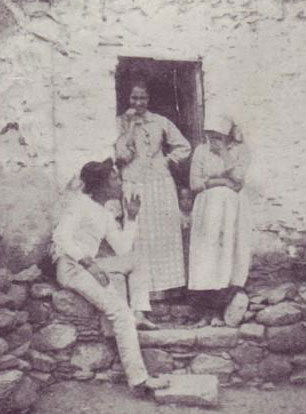Love and flowers
 1898
The lover has many opportunities of presenting his mistress with some flower, the language of which is quite intelligible. On the “ferias” and other merry meetings of a similar nature, of which there very many, the lover has excellent opportunities, of which he generally takes care to avail himself, of presenting his “moza” with a spring of thyme, to the Spanish name of which, “tomillo”, a certain meaning is made to jingle in rhyme in the established phrase, “a tus pies me humillo”, the simple interpretation of which is, “I humble myself at your feet”. If a piece of rosemary called by the people “romero”, is returned, it is taken as an unfavourable answer to the poor lover’s means in plain language, “You are a bore, sir”. But if a flower with a more compassionate meaning is returned, the suit is considered to have made a good commencement, and the gratified lover seeks such opportunities as he can find of holding light chat with the fair one at her window as he passes to and from his daily labour.
1898
The lover has many opportunities of presenting his mistress with some flower, the language of which is quite intelligible. On the “ferias” and other merry meetings of a similar nature, of which there very many, the lover has excellent opportunities, of which he generally takes care to avail himself, of presenting his “moza” with a spring of thyme, to the Spanish name of which, “tomillo”, a certain meaning is made to jingle in rhyme in the established phrase, “a tus pies me humillo”, the simple interpretation of which is, “I humble myself at your feet”. If a piece of rosemary called by the people “romero”, is returned, it is taken as an unfavourable answer to the poor lover’s means in plain language, “You are a bore, sir”. But if a flower with a more compassionate meaning is returned, the suit is considered to have made a good commencement, and the gratified lover seeks such opportunities as he can find of holding light chat with the fair one at her window as he passes to and from his daily labour.
The conversation, it must be confessed, is not quite of such a nature as one would imagine likely to be indulged in by the victims of tender passion. If one were to listen to a dialogue between two young persons in such a Romeo and Juliet-like position, he would be astonished to hear that the deepest sighs of an ardent passion were breathed forth as the accompaniment to questions about the price of potatoes, the appearance of the crops, the labour of the farm, the work of the household, and indeed, anything but the great, the all-important subject that brings them together. That, in fact, which is nearest their hearts is never once alluded to.
Elizabeth Murray, Sixteen years of an artist’s life in Morocco, Spain and the Canary Islands (1859)



